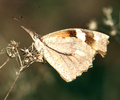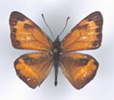Libytheinae
Snout Butterflies
Akito Y. Kawahara and Niklas Wahlberg


This tree diagram shows the relationships between several groups of organisms.
The root of the current tree connects the organisms featured in this tree to their containing group and the rest of the Tree of Life. The basal branching point in the tree represents the ancestor of the other groups in the tree. This ancestor diversified over time into several descendent subgroups, which are represented as internal nodes and terminal taxa to the right.

You can click on the root to travel down the Tree of Life all the way to the root of all Life, and you can click on the names of descendent subgroups to travel up the Tree of Life all the way to individual species.
For more information on ToL tree formatting, please see Interpreting the Tree or Classification. To learn more about phylogenetic trees, please visit our Phylogenetic Biology pages.
close boxIntroduction
The Libytheinae include fifteen species, two of which are fossils (Kawahara, accepted). Extant species in the subfamily have an unusual global distribution with several widespread species and some that are restricted to insular environments (Shields, 1985a; Kawahara 2006a).
Most species are found in forests or disturbed habitats, but some are also found in dry deserts (Shields 1985a; Kawahara 2006a,b), and at least two species (Libythea labdaca and Libytheana carinenta) are known to migrate in large numbers (Shields, 1987). The male is typically territorial, and both sexes cryptically rest on branches. The number of annual generations is typically two, but this can be affected by environmental factors such as hostplant availability, rainfall, and temperature. The egg is generally laid on buds of Celtis (Celtidaceae), and in nearly all cases, the larva feeds on leaves of this plant genus.
Libytheines can be easily recognized by their exceptionally long labial palpus, although there are a few other nymphalids that have an equally long or longer labial palpus (Ackery et al., 1999). The elongated labial palpus of libytheines is believed to resemble the petiole of a dead leaf, and provide camouflage when the butterfly is at rest (Kawahara, 2003). The foreleg of the libytheine adult male is reduced, but the forleg of the female is well developed. Due to this characteristic, the Libytheinae have traditionally been treated as a separate family (e.g., Pagenstecher, 1901; 1902; 1911), or placed at the base of the Nymphalidae (e.g., Kristensen, 1976; Ackery, 1984; de Jong et al. 1996; Freitas and Brown, 2004). Recent molecular evidence also suggests a basal position of the Libytheinae with respect to the remaining Nymphalidae (Brower, 2000; Wahlberg et al. 2003; 2005).
Characteristics
At least two characters can be used to distinguish the Libytheinae from other Nymphalidae: foreleg reduced in male, but not female; lobe on ventral surface of patagium (Kawahara, accepted).
Discussion of Phylogenetic Relationships
A preliminary phylogenetic analysis of the Libytheinae was conducted (Kawahara, 2001). The parsimony analysis was based on morphological characters for eleven species of Libytheinae and two outgroups. One most parsimonious cladogram was obtained, supporting the monophyly of the subfamily and each genus in the following patterns of species-level relationships (outgroup ((Libytheana carineneta + L. fulvescens)(L. terena + L. motya))(Libythea collenettei (L. myrrha + L. celtis (L. geoffroyi + L. narina)(L. labdaca + L. laius)))). This analysis was preliminary, and the first author is currently reanalyzing the data with additional taxa and characters.
References
Ackery, P. R. 1984. Systematic and faunistic studies on butterflies. In R. I. Vane-Wright and P. R. Ackery [eds.], The biology of butterflies, pp. 9-21. Academic Press, London.
Ackery, P. R., R. de Jong, and R. I. Vane-Wright. 1999. The butterflies: Hedyloidea, Hesperioidea, and Papilionoidea. Pages 264-300 in: Lepidoptera: Moths and Butterflies. 1. Evolution, Systematics, and Biogeography. Handbook of Zoology Vol. IV, Part 35. N. P. Kristensen, ed. De Gruyter, Berlin and New York.
Boisduval, J. A., P. Rambur, and A. Graslin. 1832. Collection iconographique et historique des chenilles, ou description et figures des chenilles d’Europe, avec l’histoire de leurs métamorphoses, et des applications à l’agriculture. [unpaginated]. Librarie Encyclopédique de Roret, Paris.
Brower, A. V. Z. 2000. Phylogenetic relationships among the Nymphalidae (Lepidoptera), inferred from partial sequences of the wingless gene. Proceedings of the Royal Society B, 267: 1201–1211.
de Jong, R., R. I. Vane-Wright, and P. R. Ackery. 1996. The higher classification of butterflies (Lepidoptera): problems and prospects. Entomologica Scandinavica, 27: 65-101.
Freitas, A. V. L. and K. S. Brown, Jr. 2004. Phylogeny of the Nymphalidae (Lepidoptera: Papilionoidea). Systematic Biology, 53: 363–383.
Kawahara, A. Y. 2001. Systematics of the snout butterflies (Lepidoptera: Nymphalidae: Libytheinae), with an emphasis on the morphology and phylogeny. xiii, 162 pp. Honors Thesis. Cornell University, Ithaca, New York.
Kawahara, A. Y. 2003. Behavioral observations of Libytheana carinenta Cramer. News of the Lepidopterists' Society, 45: front cover + 107-108, 127.
Kawahara, A. Y. 2006a. Biology of the snout butterflies (Nymphalidae: Libytheinae), Part 1: Libythea Fabricius. Transactions of the Lepidopterological Society of Japan, 57(1): 13-33.
Kawahara, A. Y. 2006b. Biology of the snout butterflies (Nymphalidae: Libytheinae), Part 2: Libytheana Michener. Transactions of the Lepidopterological Society of Japan, 57(3): 265-277.
Kawahara, A. Y. (accepted). Revision of the Extant and Fossil Snout Butterflies (Lepidoptera: Nymphalidae: Libytheinae). Thomas Say Publications in Entomology, Monographs. Lanham, Maryland.
Kristensen, N. P. 1976. Remarks on the family-level phylogeny of butterflies (Insecta, Lepidoptera, Rhopalocera). Zeitschrift für zoologische Systematik und Evolutionsforschung, 14: 25-33.
Motono, A. 1993. Libytheidae of the world. 52 pp. Kirihara Shoten, Tokyo.
Pagenstecher, A. 1901. Libytheidae. Das Tierreich, 14: 1-18.
Pagenstecher, A. 1902. Lepidoptera Rhopalocera: Fam. Libytheidae, fascicle 5, pp. 1-4. In P. Wytsman [ed.], Genera Insectorum, Bruxelles.
Pagenstecher, A. 1911. Libytheidae. In C. Aurivillius and H. Wagner [eds.], Lepidopterorum catalogus, 3. 12 pp. W. Junk, Berlin.
Shields, O. 1984. A revised, annotated checklist of world Libytheidae. Journal for research on the Lepidoptera, 22: 264-266.
Shields, O. 1985a. Zoogeography of the Libytheidae (snouts or breaks) [sic]. Tokurana (Acta Rhopalocera), 9: 1-58.
Shields, O. 1985b. Southeast Asian affinities in Colorado Oligocene Libytheidae. Tokurana (Acta Rhopalocera) Special, 1: 13-24.
Shields, O. 1987. A review of migration in Libytheidae. Tokurana (Acta Rhopalocera), 12 (2): 1-14.
Wahlberg, N., Weingartner, E. & Nylin, S. 2003. Towards a better understanding of the higher systematics of Nymphalidae (Lepidoptera: Papilionoidea). Molecular Phylogenetics and Evolution, 28: 473–484.
Wahlberg, N., Braby, M. F., Brower, A. V. Z., de Jong, R., Lee, M.- M., Nylin, S., Pierce, N. E., Sperling, F. A. H., Vila, R., Warren, A. D., and E. Zakharov. 2005. Synergistic effects of combining morphological and molecular data in resolving the phylogeny of butterflies and skippers. Proceedings of the Royal Society B, 272: 1577–1586.
Title Illustrations

| Scientific Name | Libytheana carinenta |
|---|---|
| Specimen Condition | Live Specimen |
| Source | #1226037 |
| Source Collection | Bugwood Network/Forestry Images |
| Image Use |
 This media file is licensed under the Creative Commons Attribution-NonCommercial License - Version 3.0. This media file is licensed under the Creative Commons Attribution-NonCommercial License - Version 3.0.
|
| Copyright | © Jerry A. Payne, USDA ARS |
| Scientific Name | Libythea geoffroyi |
|---|---|
| Specimen Condition | Dead Specimen |
| Identified By | Akito Y. Kawahara |
| Sex | Male |
| Life Cycle Stage | Adult |
| View | Habitus |
| Copyright |
© Akito Y. Kawahara

|
| Scientific Name | Libythea collenettei |
|---|---|
| Identified By | Akito Y. Kawahara |
| Sex | Male |
| Life Cycle Stage | Adult |
| View | Habitus |
| Copyright |
© Akito Y. Kawahara

|
About This Page
Akito Y. Kawahara

University of Maryland, College Park, MD, USA
Niklas Wahlberg

University of Turku, Finland
Correspondence regarding this page should be directed to Akito Y. Kawahara at and Niklas Wahlberg at
Page copyright © 2009 Akito Y. Kawahara and Niklas Wahlberg
All Rights Reserved.
- Content changed 03 December 2007
Citing this page:
Kawahara, Akito Y. and Niklas Wahlberg. 2007. Libytheinae . Snout Butterflies. Version 03 December 2007 (under construction). http://tolweb.org/Libytheinae/12193/2007.12.03 in The Tree of Life Web Project, http://tolweb.org/








 Go to quick links
Go to quick search
Go to navigation for this section of the ToL site
Go to detailed links for the ToL site
Go to quick links
Go to quick search
Go to navigation for this section of the ToL site
Go to detailed links for the ToL site